人教版(2019)高中英语选择性必修第二册 Unit1 Science and Scientists Using language 1 活动观课件(共31张PPT)
文档属性
| 名称 | 人教版(2019)高中英语选择性必修第二册 Unit1 Science and Scientists Using language 1 活动观课件(共31张PPT) |  | |
| 格式 | pptx | ||
| 文件大小 | 9.2MB | ||
| 资源类型 | 教案 | ||
| 版本资源 | 人教版(2019) | ||
| 科目 | 英语 | ||
| 更新时间 | 2023-03-12 12:44:54 | ||
图片预览

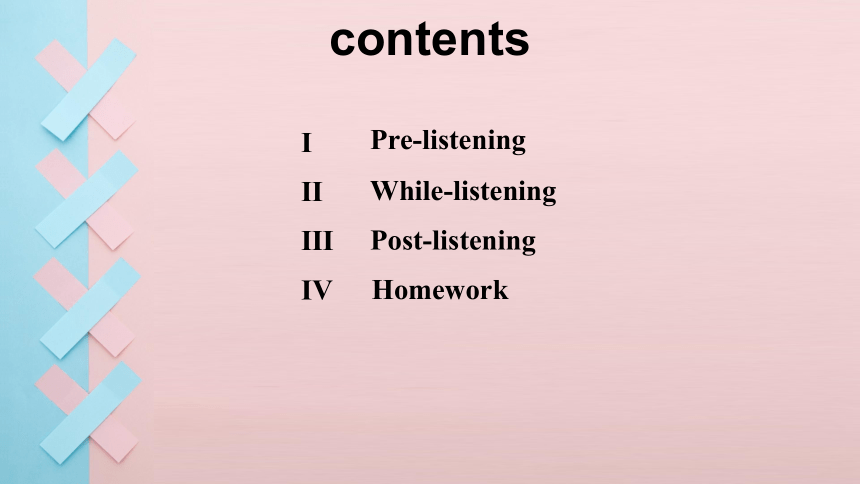
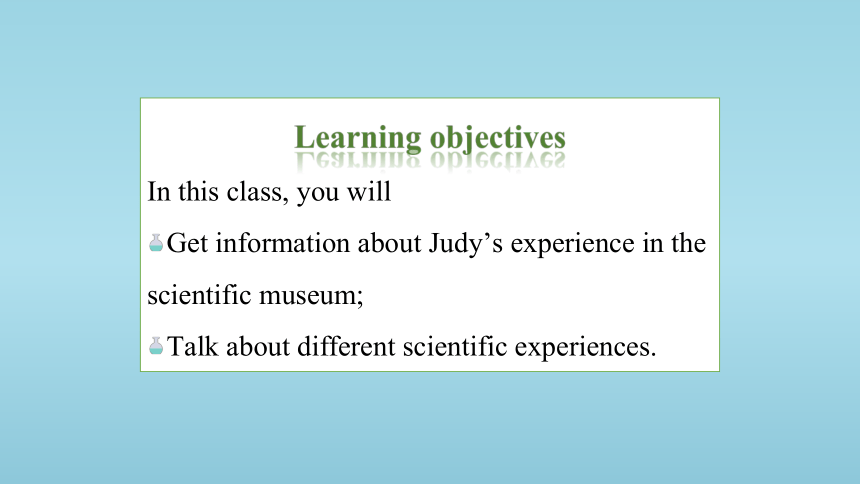
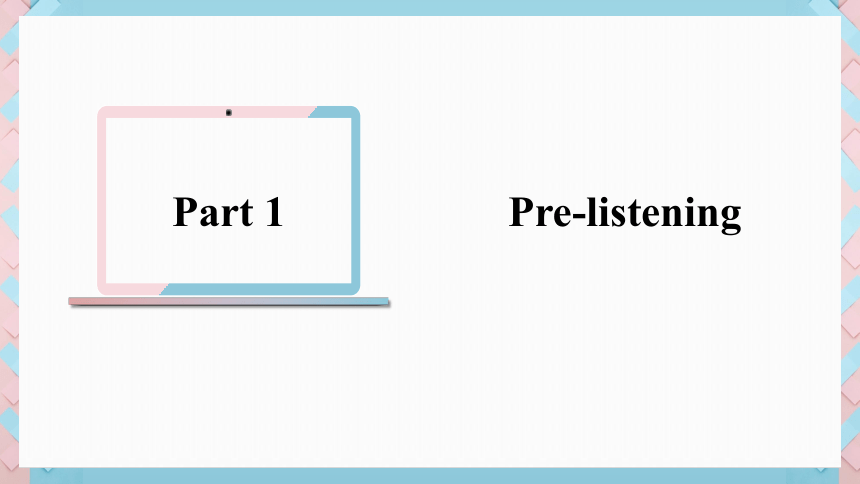

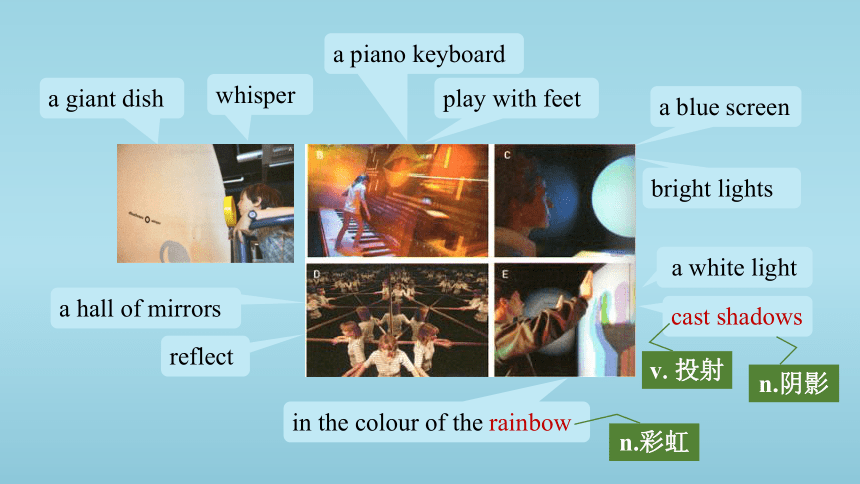
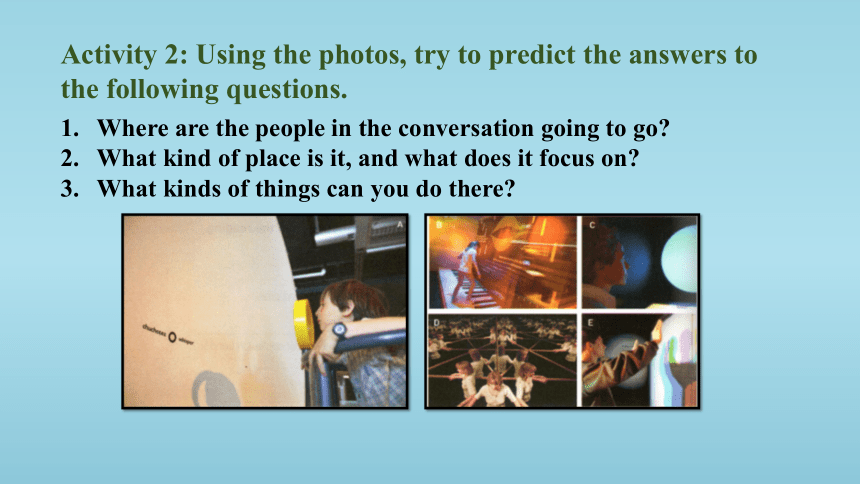
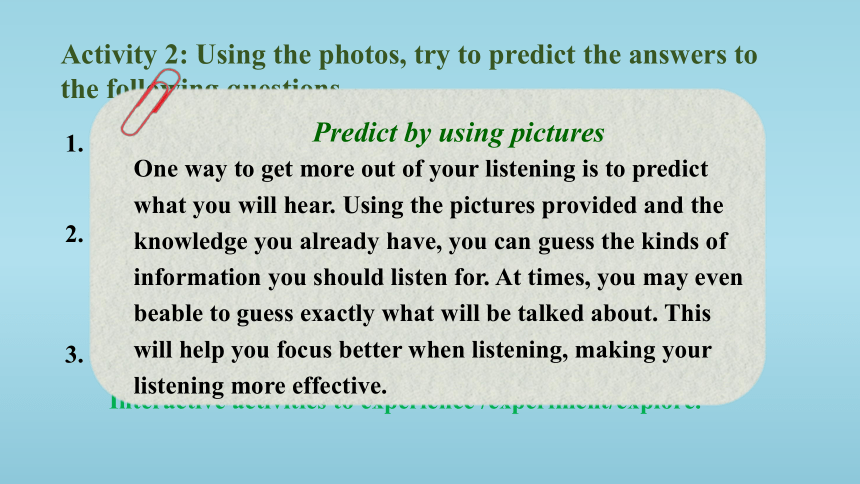

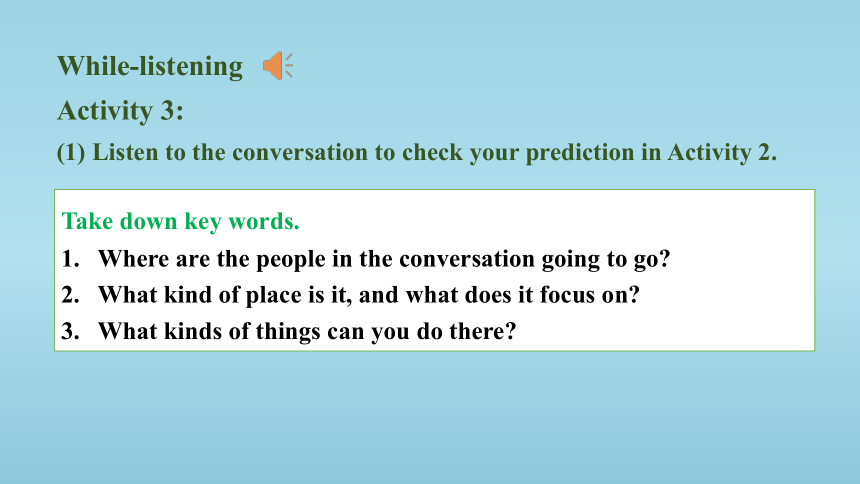

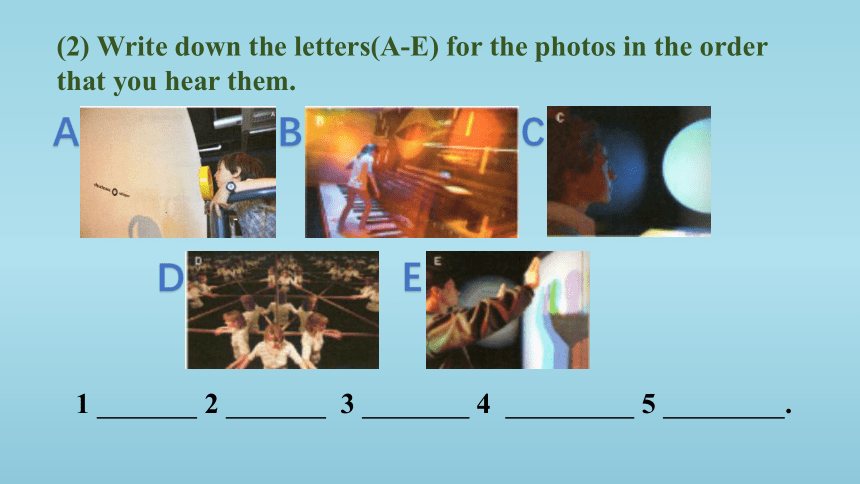
文档简介
(共31张PPT)
Period 3 Using language1
Unit 1 Science and Scientists
Post-listening
While-listening
contents
Ⅰ
Ⅱ
Ⅲ
Pre-listening
Ⅳ
Homework
Learning objectives
In this class, you will
Get information about Judy’s experience in the scientific museum;
Talk about different scientific experiences.
Pre-listening
Part 1
Pre-listening
Activity 1: Look at the photos and talk about what these activities have to do with science.
What can you see in the picture
What is he/she doing
Why is he/she doing that
a piano keyboard
a giant dish
whisper
play with feet
a blue screen
reflect
a hall of mirrors
bright lights
a white light
cast shadows
in the colour of the rainbow
v.投射
n.阴影
n.彩虹
Where are the people in the conversation going to go
What kind of place is it, and what does it focus on
What kinds of things can you do there
Activity 2: Using the photos, try to predict the answers to the following questions.
Activity 2: Using the photos, try to predict the answers to the following questions.
Where are the people in the conversation going to go
What kind of place is it, and what does it focus on
What kinds of things can you do there
A science museum/centre.
A place for delight, education and inspiration.
Scientific phenomena / discoveries on sound and light .
Interactive activities to experience /experiment/explore.
One way to get more out of your listening is to predict what you will hear. Using the pictures provided and the knowledge you already have, you can guess the kinds of information you should listen for. At times, you may even beable to guess exactly what will be talked about. This will help you focus better when listening, making your listening more effective.
Predict by using pictures
While-listening
Part 2
While-listening
Activity 3:
(1) Listen to the conversation to check your prediction in Activity 2.
Take down key words.
Where are the people in the conversation going to go
What kind of place is it, and what does it focus on
What kinds of things can you do there
Where are the people in the conversation going to go
What kind of place is it, and what does it focus on
What kinds of things can you do there
(1) Listen to the conversation to check your prediction in Activity 2.
They are going to a science museum.
It is a science museum that focuses on letting visitors experience science through interactive learning exhibition.
You can probably try different activities to learn about sound, light, reflection, and soon.
For example you can go to a room with many mirrors facing each other so it looks like there are many copies of you! Or you can play with a big piano on the floor.
(2) Write down the letters(A-E) for the photos in the order that you hear them.
1 2 3 4 5 .
A
B
C
E
D
(2) Write down the letters(A-E) for the photos in the order that you hear them.
1
D
a blue screen
tiny bright lights
blood cells
a hall of mirrors
see myself reflected thousands of times
2
C
(2) Write down the letters(A-E) for the photos in the order that you hear them.
3
E
B
a white light
cast different shadows
in every colour of the rainbow
a giant piano keyboard
use your feet to play
play voices of classical singers
4
(2) Write down the letters(A-E) for the photos in the order that you hear them.
5
A
a giant dish
reflect the sound back
speak in a whisper
17 metres away
1 D 2 C 3 E 4 B 5 A .
Activity 4: Listen again and complete the descriptions of the photos about scientific experiences in the conversation.
Photo A: A giant dish; when you speak into it, it the sound back and .
You can use it to speak in a to someone 17 metres away.
Photo B: A giant that you can use your feet to play. Instead of playing the sounds of a piano, it plays the voices of .
reflects
makes it louder
whisper
piano keyboard
classical singers
Photo C: You look at a blue screen for a while, and then suddenly you can see moving around on it. These are our .
Photo D: A where you can see yourself reflected thousands of times.
Photo E: You stand in front of , and it casts different shadows of you, in the rainbow.
Activity 4: Listen again and complete the descriptions of the photos about scientific experiences in the conversation.
tiny bright lights
own blood cells
hall of mirrors
a white light
every colour of
Post-listening
Part 3
Post-listening
Activity5: Fill in the blanks with the words and expressions in the box to finish the summary of the conversation.
piano keyboard a hall of mirrors whisper
blood cells sound experimented with
the rainbow reflected tiny bright lights
light a field trip cast different shadows
Judy had to a science museum with her classmates last week. First she went to an area for . In Judy saw herself reflected thousands of times.
a field trip
light
a hall of mirrors
piano keyboard a hall of mirrors whisper
blood cells sound experimented with
the rainbow reflected tiny bright lights
light a field trip cast different shadows
She also a blue screen and saw her own
moving around like .
experimented with
blood cells
tiny bright lights
The thing Judy liked better was that a white light shadows of Judy in every colour of . Later Judy went to the area for .
cast different
the rainbow
sound
Judy played a giant with her feet, and it even produced the voices of classical singers. She also played a giant dish, which the sound back and made it louder so that you could to someone 17 metres away.
piano keyboard
reflected
whisper
piano keyboard a hall of mirrors whisper
blood cells sound experimented with
the rainbow reflected tiny bright lights
light a field trip cast different shadows
Activity 6: Talk about something more on the scientific museum (Page 7, Activity 5).
The conversation is about the City of Science and Industry, a museum in Paris. Would you like to goto this museum Why or why not
Yes. I would like to go to this museum to see the blue screen. I am curious to know what on earth is going on there and why I can see my blood cells moving around like tiny bright lights. I am sure it will be a lot of fun.
No. It is not convenient because it is too far from China and there is no need to go so far when we have so many interesting places at home.
We can’t speak French and will have trouble in understanding what to do there .
Are there any museums like this in China What other interesting museums are there
Yes, there are, for example, the China Science and Technology Museum in Beijing and the Shanghai Science and Technology Museum.
Activity 7: Talk about the scientific research or experiment that you are interested in.
(1) Brainstorm the scientific research or experiment (Page7, Activity 6&7).
Example
What scientific phenomenon is the example about
Do you know the phenomenon Where did you know it
What other scientific research/experiments have you ever done or read about
EXAMPLE
Today, I want to talk to you about a very strange phenomenon called a non-Newtonian fluid. You can make it easily using equal parts of water and cornflour, like I have here. A non-Newtonian fluid is strange because you can pour it like a liquid, but if you put any pressure on it, it suddenly becomes hard as concrete.
v. 倾倒
n. 混凝土
EXAMPLE
In fact, it becomes hard enough to stand on. Then, as soon as you take the pressure off, it becomes a liquid again. This shows that it is possible that something can exist as a liquid and a solid at the same time.
n. 固体
What scientific phenomenon is the example about
Do you know the phenomenon Where did you know it
What other scientific research/experiments have you ever done or read about
(1) Brainstorm the scientific research or experiment (Page7, Activity 6&7).
An on-Newtonian fluid.
Yes. In TV programs or books.
For example: the positive and negative charges of molecules.
n. 分子/微粒
(2) Read the expressions to talk about scientific phenomena (Page 7) .
EXAMPLE
Today, I want to talk to you about a very strange phenomenon called ...
You can make it easily using ...
This shows that ...
...can/can not exist in the form of a solid/gas and a liquid/plasma...
...is both a ... and a ... at the same time... how light/sound is reflected...
the existence of other... This occurs when... If you..., it will become...
That demonstrates... This experiment/research shows...
Through this, we know that... We can prove that...
This evidence proves...
(2) Read the expressions to talk about scientific phenomena (Page 7) .
Homework
Part 5
Requirements
Use the example and useful expressions in Activity 7 on page 7 to help you.
Homework
Make a short presentation about the scientific research or experiment.
Period 3 Using language1
Unit 1 Science and Scientists
Post-listening
While-listening
contents
Ⅰ
Ⅱ
Ⅲ
Pre-listening
Ⅳ
Homework
Learning objectives
In this class, you will
Get information about Judy’s experience in the scientific museum;
Talk about different scientific experiences.
Pre-listening
Part 1
Pre-listening
Activity 1: Look at the photos and talk about what these activities have to do with science.
What can you see in the picture
What is he/she doing
Why is he/she doing that
a piano keyboard
a giant dish
whisper
play with feet
a blue screen
reflect
a hall of mirrors
bright lights
a white light
cast shadows
in the colour of the rainbow
v.投射
n.阴影
n.彩虹
Where are the people in the conversation going to go
What kind of place is it, and what does it focus on
What kinds of things can you do there
Activity 2: Using the photos, try to predict the answers to the following questions.
Activity 2: Using the photos, try to predict the answers to the following questions.
Where are the people in the conversation going to go
What kind of place is it, and what does it focus on
What kinds of things can you do there
A science museum/centre.
A place for delight, education and inspiration.
Scientific phenomena / discoveries on sound and light .
Interactive activities to experience /experiment/explore.
One way to get more out of your listening is to predict what you will hear. Using the pictures provided and the knowledge you already have, you can guess the kinds of information you should listen for. At times, you may even beable to guess exactly what will be talked about. This will help you focus better when listening, making your listening more effective.
Predict by using pictures
While-listening
Part 2
While-listening
Activity 3:
(1) Listen to the conversation to check your prediction in Activity 2.
Take down key words.
Where are the people in the conversation going to go
What kind of place is it, and what does it focus on
What kinds of things can you do there
Where are the people in the conversation going to go
What kind of place is it, and what does it focus on
What kinds of things can you do there
(1) Listen to the conversation to check your prediction in Activity 2.
They are going to a science museum.
It is a science museum that focuses on letting visitors experience science through interactive learning exhibition.
You can probably try different activities to learn about sound, light, reflection, and soon.
For example you can go to a room with many mirrors facing each other so it looks like there are many copies of you! Or you can play with a big piano on the floor.
(2) Write down the letters(A-E) for the photos in the order that you hear them.
1 2 3 4 5 .
A
B
C
E
D
(2) Write down the letters(A-E) for the photos in the order that you hear them.
1
D
a blue screen
tiny bright lights
blood cells
a hall of mirrors
see myself reflected thousands of times
2
C
(2) Write down the letters(A-E) for the photos in the order that you hear them.
3
E
B
a white light
cast different shadows
in every colour of the rainbow
a giant piano keyboard
use your feet to play
play voices of classical singers
4
(2) Write down the letters(A-E) for the photos in the order that you hear them.
5
A
a giant dish
reflect the sound back
speak in a whisper
17 metres away
1 D 2 C 3 E 4 B 5 A .
Activity 4: Listen again and complete the descriptions of the photos about scientific experiences in the conversation.
Photo A: A giant dish; when you speak into it, it the sound back and .
You can use it to speak in a to someone 17 metres away.
Photo B: A giant that you can use your feet to play. Instead of playing the sounds of a piano, it plays the voices of .
reflects
makes it louder
whisper
piano keyboard
classical singers
Photo C: You look at a blue screen for a while, and then suddenly you can see moving around on it. These are our .
Photo D: A where you can see yourself reflected thousands of times.
Photo E: You stand in front of , and it casts different shadows of you, in the rainbow.
Activity 4: Listen again and complete the descriptions of the photos about scientific experiences in the conversation.
tiny bright lights
own blood cells
hall of mirrors
a white light
every colour of
Post-listening
Part 3
Post-listening
Activity5: Fill in the blanks with the words and expressions in the box to finish the summary of the conversation.
piano keyboard a hall of mirrors whisper
blood cells sound experimented with
the rainbow reflected tiny bright lights
light a field trip cast different shadows
Judy had to a science museum with her classmates last week. First she went to an area for . In Judy saw herself reflected thousands of times.
a field trip
light
a hall of mirrors
piano keyboard a hall of mirrors whisper
blood cells sound experimented with
the rainbow reflected tiny bright lights
light a field trip cast different shadows
She also a blue screen and saw her own
moving around like .
experimented with
blood cells
tiny bright lights
The thing Judy liked better was that a white light shadows of Judy in every colour of . Later Judy went to the area for .
cast different
the rainbow
sound
Judy played a giant with her feet, and it even produced the voices of classical singers. She also played a giant dish, which the sound back and made it louder so that you could to someone 17 metres away.
piano keyboard
reflected
whisper
piano keyboard a hall of mirrors whisper
blood cells sound experimented with
the rainbow reflected tiny bright lights
light a field trip cast different shadows
Activity 6: Talk about something more on the scientific museum (Page 7, Activity 5).
The conversation is about the City of Science and Industry, a museum in Paris. Would you like to goto this museum Why or why not
Yes. I would like to go to this museum to see the blue screen. I am curious to know what on earth is going on there and why I can see my blood cells moving around like tiny bright lights. I am sure it will be a lot of fun.
No. It is not convenient because it is too far from China and there is no need to go so far when we have so many interesting places at home.
We can’t speak French and will have trouble in understanding what to do there .
Are there any museums like this in China What other interesting museums are there
Yes, there are, for example, the China Science and Technology Museum in Beijing and the Shanghai Science and Technology Museum.
Activity 7: Talk about the scientific research or experiment that you are interested in.
(1) Brainstorm the scientific research or experiment (Page7, Activity 6&7).
Example
What scientific phenomenon is the example about
Do you know the phenomenon Where did you know it
What other scientific research/experiments have you ever done or read about
EXAMPLE
Today, I want to talk to you about a very strange phenomenon called a non-Newtonian fluid. You can make it easily using equal parts of water and cornflour, like I have here. A non-Newtonian fluid is strange because you can pour it like a liquid, but if you put any pressure on it, it suddenly becomes hard as concrete.
v. 倾倒
n. 混凝土
EXAMPLE
In fact, it becomes hard enough to stand on. Then, as soon as you take the pressure off, it becomes a liquid again. This shows that it is possible that something can exist as a liquid and a solid at the same time.
n. 固体
What scientific phenomenon is the example about
Do you know the phenomenon Where did you know it
What other scientific research/experiments have you ever done or read about
(1) Brainstorm the scientific research or experiment (Page7, Activity 6&7).
An on-Newtonian fluid.
Yes. In TV programs or books.
For example: the positive and negative charges of molecules.
n. 分子/微粒
(2) Read the expressions to talk about scientific phenomena (Page 7) .
EXAMPLE
Today, I want to talk to you about a very strange phenomenon called ...
You can make it easily using ...
This shows that ...
...can/can not exist in the form of a solid/gas and a liquid/plasma...
...is both a ... and a ... at the same time... how light/sound is reflected...
the existence of other... This occurs when... If you..., it will become...
That demonstrates... This experiment/research shows...
Through this, we know that... We can prove that...
This evidence proves...
(2) Read the expressions to talk about scientific phenomena (Page 7) .
Homework
Part 5
Requirements
Use the example and useful expressions in Activity 7 on page 7 to help you.
Homework
Make a short presentation about the scientific research or experiment.
